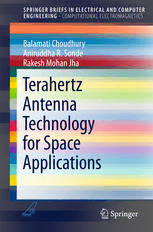
Terahertz Antenna Technology for Space Applications PDF
Preview Terahertz Antenna Technology for Space Applications
SPRINGER BRIEFS IN ELECTRICAL AND COMPUTER ENGINEERING COMPUTATIONAL ELECTROMAGNETICS Balamati Choudhury Aniruddha R. Sonde Rakesh Mohan Jha Terahertz Antenna Technology for Space Applications CSIR-NAL SpringerBriefs in Electrical and Computer Engineering Computational Electromagnetics Series editor Rakesh Mohan Jha, Bangalore, India More information about this series at http://www.springer.com/series/13885 Balamati Choudhury Aniruddha R. Sonde (cid:129) Rakesh Mohan Jha Terahertz Antenna Technology for Space Applications 123 Balamati Choudhury Rakesh MohanJha Centrefor Electromagnetics Centrefor Electromagnetics CSIR-National Aerospace Laboratories CSIR-National Aerospace Laboratories Bangalore, Karnataka Bangalore, Karnataka India India Aniruddha R.Sonde Centrefor Electromagnetics CSIR-National Aerospace Laboratories Bangalore, Karnataka India ISSN 2191-8112 ISSN 2191-8120 (electronic) SpringerBriefs inElectrical andComputer Engineering ISSN 2365-6239 ISSN 2365-6247 (electronic) SpringerBriefs inComputational Electromagnetics ISBN978-981-287-798-7 ISBN978-981-287-799-4 (eBook) DOI 10.1007/978-981-287-799-4 LibraryofCongressControlNumber:2015947808 SpringerSingaporeHeidelbergNewYorkDordrechtLondon ©TheAuthor(s)2016 Thisworkissubjecttocopyright.AllrightsarereservedbythePublisher,whetherthewholeorpart of the material is concerned, specifically the rights of translation, reprinting, reuse of illustrations, recitation, broadcasting, reproduction on microfilms or in any other physical way, and transmission orinformationstorageandretrieval,electronicadaptation,computersoftware,orbysimilarordissimilar methodologynowknownorhereafterdeveloped. The use of general descriptive names, registered names, trademarks, service marks, etc. in this publicationdoesnotimply,evenintheabsenceofaspecificstatement,thatsuchnamesareexemptfrom therelevantprotectivelawsandregulationsandthereforefreeforgeneraluse. The publisher, the authors and the editors are safe to assume that the advice and information in this book are believed to be true and accurate at the date of publication. Neither the publisher nor the authorsortheeditorsgiveawarranty,expressorimplied,withrespecttothematerialcontainedhereinor foranyerrorsoromissionsthatmayhavebeenmade. Printedonacid-freepaper SpringerScience+BusinessMediaSingaporePteLtd.ispartofSpringerScience+BusinessMedia (www.springer.com) To Dr. Sudhakar K. Rao In Memory of Dr. Rakesh Mohan Jha Great scientist, mentor, and excellent human being Dr. Rakesh Mohan Jha was a brilliant contributor to science, a won- derful human being, and a great mentor and friend to all of us associated with this book. With a heavy heart we mourn his sudden and untimely demise and dedicate this book to his memory. Foreword National Aerospace Laboratories (NAL), a constituent of the Council of Scientific and Industrial Research (CSIR), is the only civilian aerospace R&D Institution in India.CSIR-NALisahigh-technologyinstitutionfocusingonvariousdisciplinesin aerospaceandhasamandatetodevelopaerospacetechnologieswithstrongscience content, design and build small and medium-size civil aircraft prototypes, and support all national aerospace programs. It has many advanced test facilities including trisonic wind tunnels which are recognized as national facilities. The areas of expertise and competencies include computational fluid dynamics, exper- imental aerodynamics, electromagnetics, flight mechanics and control, turbo-machinery and combustion, composites for airframes, avionics, aerospace materials, structural design, analysis, and testing. CSIR-NAL is located in Bangalore, India, with the CSIR Headquarters being located in New Delhi. CSIR-NAL and Springer have recently signed a cooperation agreement for the publication of selected works of authors from CSIR-NAL as Springer book vol- umes. Within these books, recent research in the different fields of aerospace that demonstrateCSIR-NAL’soutstandingresearchcompetenciesandcapabilitiestothe global scientific community will be documented. ThefirstsetoffivebooksarefromselectedworkscarriedoutattheCSIR-NAL’s CentreforElectromagneticsandarepresentedasapartoftheseriesSpringerBriefs in Computational Electromagnetics, which is a sub-series of SpringerBriefs in Electrical and Computer Engineering. CSIR-NAL’s Centre for Electromagnetics mainly addresses issues related to electromagnetic (EM) design and analysis carried out in the context of aerospace engineering in the presence of large airframe structures, which is vastly different and in contrast to classical electromagnetics and which often assumes a free-space ambience. The pioneering work done by the Centre for Electromagnetics in some of these niche areas has led to founding the basis of contemporary theories. For example, the geodesic constant method (GCM) proposed by the scientists of the Centre for Electromagnetics is immensely popular with the peers worldwide, and forms the basis for modern conformal antenna array theory. ix x Foreword TheactivitiesoftheCentreforElectromagneticsconsistof(i)Surfacemodeling andraytracing,(ii)Airborneantennaanalysisandsiting(foraircraft,satellitesand SLV),(iii)Radarcrosssection(RCS)studiesofaerospacevehicles,includingradar absorbing materials (RAM) and structures (RAS), RCS reduction and active RCS reduction, (iv) Phased antenna arrays, conformal arrays, and conformal adaptive array design, (v) Frequency-selective surface (FSS), (vi) Airborne and ground-based radomes, (vii) Metamaterials for aerospace applications including in the Terahertz (THz) domain, and (viii) EM characterization of materials. It is hoped that this dissemination of information through these SpringerBriefs will encourage new research as well as forge new partnerships with academic and research organizations worldwide. Shyam Chetty Director CSIR-National Aerospace Laboratories Bangalore, India Preface In the pursuit of extracting more information about our universe, terahertz tech- nology is taking center stage in achieving high data rate communications. This technology uses the spectrum that lies in between the microwave and the infrared region with frequencies ranging from 300 GHz to 3 THz. The terahertz band providesatransitionbetweentheelectronicandthephotonicregionsthusadopting important characteristics from these regimes. These characteristics corresponding with the progress in semiconductor technology help researchers to exploit this hitherto unexplored domain for a variety of applications. This relatively new technology is now being extensively researched as it finds numerous applications across disciplines such as communication systems, bio-medicalimaging, andsecurity systems,toname afew.Thisdiversificationhas forced the researchers to come up with feasible and novel devices for the sources, antennas, detectors, etc. The two major challenges where technology needs further exploration, are the implementation of compact, consistent and cheap terahertz sources, and high sensitivity terahertz detectors. Additional complexities involved in scaling from the microwave domain also need to be specifically mapped and managed. The lack of feasible terahertz sources has hindered the direct applications of terahertztechnologyinvariousareas.Realizationofnanotechnologyhasledtothe creation of devices such as QCLs, uni-travelling-carrier photo diodes and RTDs providingnewavenuestogenerateterahertzradiation.Criticalimprovementsinthe design and characteristics of antennas and antenna arrays are for realizing the desired requirements. Scaling of the existing technologies to adapt to the terahertz region leads to inefficient designs and does not give optimum solutions. Advancementsinmicromachiningtechniques havebroken thetraditionalnormsof manufacturing, allowing one to fabricate novel, highly integrated devices. Integrationofthefunctionalelementsprovidesbettertransmission,radiationwitha higher order of reliability and compactness. Fabrication of arrays to improve the directivity and the gain of the systems has become much more convenient. xi
